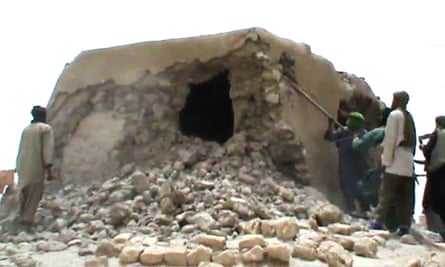Should acts of cultural destruction that happen during conflict be classed as war crimes? That is the precedent being set by the current trial of Ahmad al-Mahdi at the international criminal court (ICC) in The Hague. Al-Mahdi has pleaded guilty to leading a group that destroyed most of the architecturally beautiful, historically precious mausoleums in Timbuktu, Mali, when it was under Islamist rule in 2012.
It may seem a clear-cut case, a one-sided argument. Attacks on art and architecture have become a terrifyingly routine weapon in the hands of religious extremists. It is so easy to blow up a temple, to smash a statue. And these assaults on “idolatry” – as the extremists brand them – are not just upsetting for archaeologists. From the blowing up of Afghan Buddhas that eerily preceded the attack on the World Trade Center to the horrible confluence of vandalism and cruelty in Palmyra, it is clear that for those who psych themselves up to destroy great art, it is just a short step to killing people.
Yet the two are not the same. The most precious work of art in the world is still worth less than a single human life. War crime as a category must be kept distinct. It needs to be highly specific. The destruction of art is vile and offensive to many – but it is not mass murder and we should not pretend it is the same, nor that it belongs in the same court. There is potential for absurdity and moral confusion if artistic vandalism becomes a matter for The Hague.
That’s in part because art is being destroyed all the time, sometimes by neglect, sometimes by ignorance, sometimes even by misplaced love. Some art experts believe that restorations of such cultural glories as the Sistine Chapel and The Last Supper were done so badly that they damaged what they claimed to save. Should those culprits be brought before the ICC? The decay of Pompeii is becoming so scandalous that people might press for a case there too.

In war, both sides destroy art, usually as collateral damage. In the second world war, the French city of Caen was virtually obliterated by allied bombing, its precious medieval heritage devastated. Allied bombs also destroyed Benozzo Gozzoli’s famous frescoes in the Campo Santo in Pisa. Caravaggio paintings were lost in the bombing of Berlin. The abbey of Monte Cassino was used as a battleground and pulverised in the process. Were the pilots and generals responsible for these terrible attacks prosecuted for war crimes in 1945?
Of course not. The trials at Nuremberg had a far more pressing task – to get the full measure of the Nazi Holocaust and prosecute those responsible for the worst genocide in history. Today’s concept of war crime, with genocide its ultimate horror, flows from the sheer scale of Nazi mass murder and the need to ensure nothing like it ever happens again. It would have been monstrous to classify the cultural destruction of the second world war, the worst of which was often caused by British and American bombs, in a similar moral sphere to Nazi crimes against humanity.
It would have been equally misplaced for the court at Nuremberg to treat the destruction of Jewish culture in eastern Europe as equal to the mass extermination of millions of Jewish lives. The Degenerate Art exhibition in Munich in 1937, at which the Nazis mocked and vilified modern works, was an insight into their ideology, but a footnote compared with the horror of Auschwitz.
Culture can be renewed, remade, reinvented. Human life cannot. The organised torture and murder of human beings is what war crime should always, and unmistakably, mean. So while we mourn the loss of art or cultural artefacts, we need to keep a moral perspective in which the true crimes of war can be seen for what they are, and eradicated from the world.

